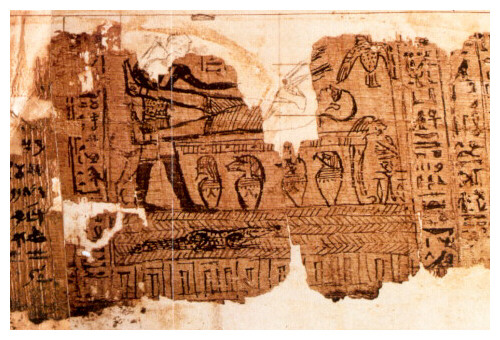


Book of Abraham and Egyptian Material
In early July 1835, Joseph Smith and other Latter-day Saints in Kirtland, Ohio, acquired four ancient Egyptian mummies and several papyrus scrolls from Michael Chandler, an antiquities dealer visiting the area. Later that year and in early 1836, Joseph Smith and his scribes spent considerable time engaged in two separate but related endeavors: the translation of the Book of Abraham, a first-person narrative recounting a portion of the life of the biblical patriarch Abraham; and a language-study effort that produced a number of Egyptian alphabet and grammar manuscripts. The Book of Abraham was published in the church’s periodical Times and Seasons in Nauvoo, Illinois, in March and May 1842. This published version was introduced as “A translation Of some ancient Records that have fallen into our hands, from the Catecombs of Egypt, purporting to be the writings of Abraham, while he was in Egypt, called the Book of Abraham, written by his own hand, upon papyrus.” The Book of Abraham was officially accepted as scripture by the Church of Jesus Christ of Latter-day Saints in 1880 and is included today in the volume of scripture known as the Pearl of Great Price. For further introductory information, see “Introduction to Book of Abraham Manuscripts,” “Introduction to Egyptian Material,” and “
,” on this website.
The following documents or other materials related to the Book of Abraham are available on this website:
3. Warren Parrish Copy of Book of Abraham Manuscript, circa July–circa November 1835 [Abraham 1:4–2:2]
The following Egyptian materials are available on this website:
Additionally, the Abraham and Egyptian materials and projects are referenced elsewhere in Joseph Smith’s papers. Some of these references are listed below:
Joseph Smith, Journal, 1 Oct. 1835; 3 Oct. 1835; 7 Oct. 1835; 14 Nov. 1835; 17 Nov. 1835; 19 Nov. 1835; 24 Nov. 1835; 25 Nov. 1835; 26 Nov. 1835; 12 Dec. 1835; 16 Dec. 1835; 17 Feb. 1836; 6 May 1838; 23 Feb. 1842; 2 Mar. 1842; 4 Mar. 1842; 8 Mar. 1842